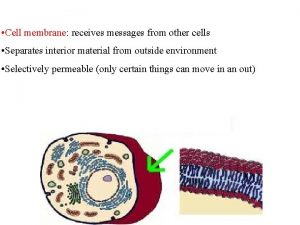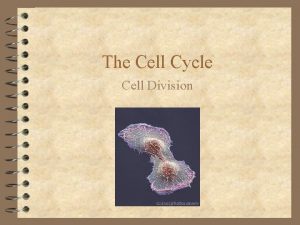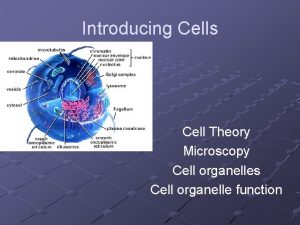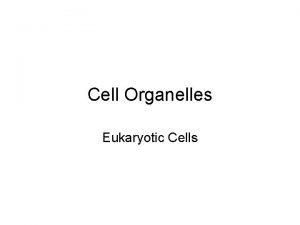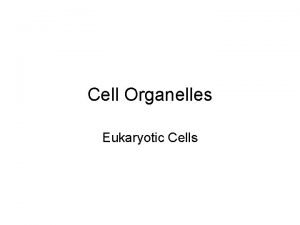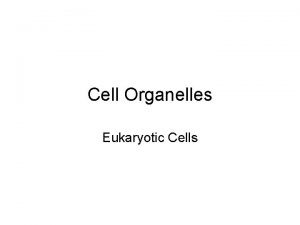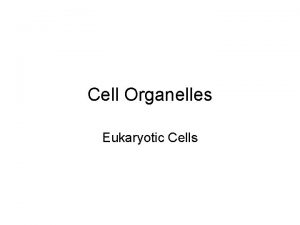The Diversity of Cells Diversity of Cells Cell


















- Slides: 18

The Diversity of Cells

Diversity of Cells Cell- smallest unit that can perform all processes necessary for life Robert Hooke- 1 st person to describe cells via a microscope in 1665 Cork – first cells seen

Plant cell vs. Animal cell Have a cell wall Easier to see & differentiate in drawings No cell wall Harder to see & differentiate in drawings Hooke didn't think animals made of cells

Cells in other Organisms Leeuwenhoek- discovered “animalcules” Single-celled pond organisms (protists) Also looked at animal blood & bacteria

Cell theory 1. All organisms are made of one or more cells 2. Cell is basic unit of all living things Schwann wrote 1 st two parts of theory (1839) Had contributions from Schleiden who studied plants 3. All cells come from existing cells Virchow, a doctor, discovered the last part (1858)

Cell size Too small to see w/out microscope (50 human cells in one. ) Large- yolk of bird egg Small- most cells Cells must take in food & get rid of wastes If cells get too large, cell can't take in enough food or get rid of enough wastes (limited by surface area) Surface area to volume ratio = surface area/ volume

Surface Area to Volume Ratio Calculate the surface area to volume ratio of a cube whose sides measure 2 cm. Surface area = # of sides x area of side = 6 x (2 cm x 2 cm) = 24 cm 2 Volume = volume of cube = l x w x h = 2 cm x 2 cm = 8 cm 3 Surface area / volume = 24 cm 2 / 8 cm 3 =3/1

Your Turn • Calculate the surface area-to-volume ratio of a cube whose sides are 3 cm long. Surface area = # of sides x area of side = 6 x (3 cm x 3 cm) = 54 cm 2 Volume = volume of cube = l x w x h = 3 cm x 3 cm = 27 cm 3 Surface area / volume = 54 cm 2 / 27 cm 3 =2/1

Analysis • Which Cube has the greater surface area-tovolume ratio? • The cube with 2 cm sides • What is the relationship between the length of a side & the surface area-to-volume ratio of a cell? – The larger the cell is, the smaller the surface area-to-volume ratio is.

Parts of a Cell • Cell membrane – protective layer that covers the surface & acts as a barrier – Controls what goes in and out of the cell • Cytoplasm- fluid & contents inside the cell – Gel-like fluid in which organelles can float

Parts of a Cell • Organelles – structures that perform specific functions within the cell – Most organelles have membranes • Some float in cytoplasm & are attached to membrane

Parts of Cells • Genetic Material – DNA- deoxyribonucleic acid- genetic material that carries information needed to made new cells & new organisms – Controls activities of cell – Many cells have DNA enclosed inside nucleus

Prokaryotic Cells • Single-celled organisms that have NO nucleus or membrane bound organelles – Most common- bacteria • Smallest cells known • No nucleus, DNA is long & circular • Ribosomes- tiny round organelles made of protein & used to make protein • Strong, weblike exterior cell wall (keeps shape)

Prokaryote cells

Archaea Single-celled prokaryotes with some characteristics similar to bacteria & eukaryotes • Bacteria • No nucleus • No membrane organelles • Circular DNA • Eukaryotes • Ribosomes like eukaryotes

Archaea • Make up of cell membrane & cell walls are unique • Live in places no other organisms live • Extremophile-places where conditions are extreme – Heat-loving- hot springs – Salt-loving- extreme salty water • Methane-making- kind of gas found in swamps

Eukaryotic Cells • Largest cells containing a nucleus & other membrane bound organelles (10 X bacteria) – Organelles- similar to organs that carry out specific functions w/in cell • All living things, except bacteria & archaea are eukaryotes • Many eukaryotes are multicellular – Animals, plants, fungi, amoeba, some algae, yeasts

Eukaryotic Cells
 Genetic diversity and biodiversity
Genetic diversity and biodiversity Genetic diversity vs species diversity
Genetic diversity vs species diversity Sphenoid paranasal sinus
Sphenoid paranasal sinus Principal cells vs intercalated cells
Principal cells vs intercalated cells Pineal gland
Pineal gland Somatic vs gamete
Somatic vs gamete Why dna is more stable than rna
Why dna is more stable than rna Red blood cells and white blood cells difference
Red blood cells and white blood cells difference What organisms are made of eukaryotic cells
What organisms are made of eukaryotic cells Animal cells and plant cells venn diagram
Animal cells and plant cells venn diagram Prokaryotic cell
Prokaryotic cell Organelle trail
Organelle trail Masses of cells form and steal nutrients from healthy cells
Masses of cells form and steal nutrients from healthy cells Younger cells cuboidal older cells flattened
Younger cells cuboidal older cells flattened 4 types of eukaryotic cells
4 types of eukaryotic cells Prokaryotic vs eukaryotic cells
Prokaryotic vs eukaryotic cells Nondisjunction in meiosis
Nondisjunction in meiosis Cell substance
Cell substance Germ cell vs somatic cells
Germ cell vs somatic cells


















